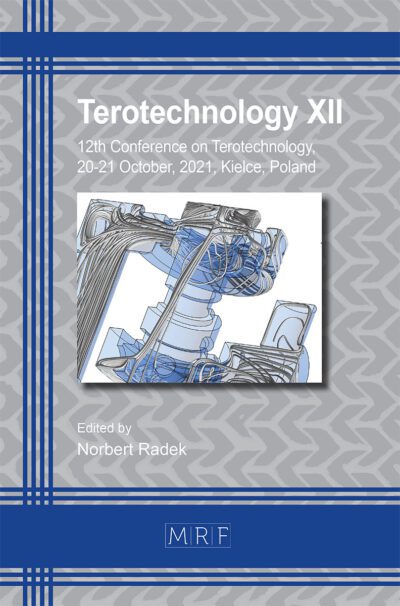Framework for determining and simulating tensile properties of smart composite FDM printed parts
Mohamed Khalil Homrani, Anthonin Demarbaix, Imi Ochana, François Ducobu
Abstract. Fused deposition modeling (FDM) is an additive manufacturing technique with good precision and moderate tolerances. Utilizing Finite Element Analysis (FEA) in literature is now key to studying the properties of these printed parts. The nature of the FDM process results in anisotropic inner structures with microscopic voids that are heavily affected by printing parameters. Even more so than the latter, composite coextrusion FDM printed parts possesses anisotropy due to the joining of the two filaments in the melt phase. These effects need to be examined and incorporated in an adequate digital twin. There exists a valid alternative to simulating this complex anisotropy, with the creation of Equivalent Homogenized Material. This study aims to bridge the gap between experimental data and FEA models for smart composite FDM parts. The goal is to establish a framework for determining effective homogenous mechanical properties of said parts. The Rule of Mixtures (ROM) method is first examined, and the limitations quickly become apparent, as the method fails to distinguish between two study cases with similar volume fractions but different fiber/matrix layouts. The second method, Representative Volume Elements (RVE), does not possess such a disadvantage. With an adequate convergence study on RVE size and fiber distribution, the calculated equivalent material’s properties show good agreement with experimental results, at a greatly increased computation cost.
Keywords
Finite Element, Tensile Testing, Equivalent Materials, 3D Printing
Published online 5/7/2025, 10 pages
Copyright © 2025 by the author(s)
Published under license by Materials Research Forum LLC., Millersville PA, USA
Citation: Mohamed Khalil Homrani, Anthonin Demarbaix, Imi Ochana, François Ducobu, Framework for determining and simulating tensile properties of smart composite FDM printed parts, Materials Research Proceedings, Vol. 54, pp 274-283, 2025
DOI: https://doi.org/10.21741/9781644903599-30
The article was published as article 30 of the book Material Forming
![]() Content from this work may be used under the terms of the Creative Commons Attribution 3.0 license. Any further distribution of this work must maintain attribution to the author(s) and the title of the work, journal citation and DOI.
Content from this work may be used under the terms of the Creative Commons Attribution 3.0 license. Any further distribution of this work must maintain attribution to the author(s) and the title of the work, journal citation and DOI.
References
[1] Terry T Wohlers and Tim Caffrey. Wohlers report 2019: 3d printing and additive manufacturing state of the industry annual worldwide progress report. 2019.
[2] Hu B, Duan X, Xing Z, Xu Z, Du C, Zhou H, Chen R, Shan B. Improved design of fused deposition modeling equipment for 3D printing of high-performance PEEK parts. Mechanics of Materials. 2019 Oct 1;137:103139. https://doi.org/10.1016/j.mechmat.2019.103139
[3] Mattey R, Jewell B, Ghosh S, Sain T. Phase-field fracture coupled elasto-plastic constitutive model for 3D printed thermoplastics and composites. Engineering Fracture Mechanics. 2023 Oct 26;291:109535. https://doi.org/10.1016/j.engfracmech.2023.109535
[4] Jung CH, Kang Y, Song H, Lee MG, Jeon Y. Ultrasonic fatigue analysis of 3D-printed carbon fiber reinforced plastic. Heliyon. 2022 Nov 1;8(11). https://doi.org/10.1016/j.heliyon.2022.e11671
[5] ASTM D638-14, “Standard Test Method for Tensile Properties of Plastics”, American Society for Testing and Materials, doi: 10.1520/D0638-14. https://doi.org/10.1520/D0638-14
[6] Allouch M, Ben Fraj B, Dhouioui M, Kesssentini A, Hentati H, Wali M, Ferhi M. Mechanical, microstructural and numerical investigations of 3D printed carbon fiber reinforced PEEK. Proceedings of the Institution of Mechanical Engineers, Part C: Journal of Mechanical Engineering Science. 2024 Mar;238(6):2131-9. https://doi.org/10.1177/09544062231190534
[7] Ning F, Cong W, Qiu J, Wei J, Wang S. Additive manufacturing of carbon fiber reinforced thermoplastic composites using fused deposition modeling. Composites Part B: Engineering. 2015 Oct 1;80:369-78. https://doi.org/10.1016/j.compositesb.2015.06.013
[8] Tian X, Todoroki A, Liu T, Wu L, Hou Z, Ueda M, Hirano Y, Matsuzaki R, Mizukami K, Iizuka K, Malakhov AV. 3D printing of continuous fiber reinforced polymer composites: development, application, and prospective. Chinese Journal of Mechanical Engineering: Additive Manufacturing Frontiers. 2022 Mar 1;1(1):100016. https://doi.org/10.1016/j.cjmeam.2022.100016
[9] Modir A, Tansel I. Analysis of force sensing accuracy by using SHM methods on conventionally manufactured and additively manufactured small polymer parts. Polymers. 2022 Sep 8;14(18):3755. https://doi.org/10.3390/polym14183755
[10] Garg A, Bhattacharya A. An insight to the failure of FDM parts under tensile loading: finite element analysis and experimental study. International Journal of Mechanical Sciences. 2017 Jan 1;120:225-36. https://doi.org/10.1016/j.ijmecsci.2016.11.032
[11] Anoop MS, Senthil P. Homogenisation of elastic properties in FDM components using microscale RVE numerical analysis. Journal of the Brazilian Society of Mechanical Sciences and Engineering. 2019 Dec;41:1-6. https://doi.org/10.1007/s40430-019-2037-8
[12] R.J. Ong, J.T. Dawley and P.G. Clem: submitted to Journal of Materials Research (2003). https://doi.org
[13] van de Werken N, Koirala P, Ghorbani J, Doyle D, Tehrani M. Investigating the hot isostatic pressing of an additively manufactured continuous carbon fiber reinforced PEEK composite. Additive Manufacturing. 2021 Jan 1;37:101634. https://doi.org/10.1016/j.addma.2020.101634













